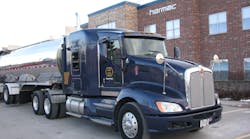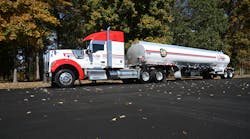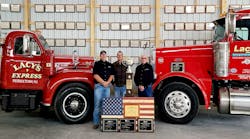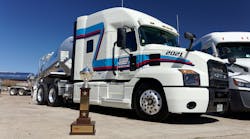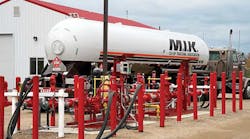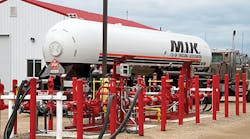By this time next year, Rockville Propane Terminal will have more than doubled its capacity. An expansion project now underway will make the Rockville, Minnesota, facility one of the largest rail-transfer propane terminals in the United States.
The expanded terminal will be able to transfer 900,000 gallons of propane a day, much of that moving from rail tankcar to storage tank to propane transport in a seamless flow. The expansion will give the facility total storage capacity of 620,000 gallons with the ability to offload 20 to 30 tankcars a day and two transport loading bays capable of loading six trucks per hour.
“We built this facility three years ago, and it has been an incredible success,” says Carl Wenner, who along with brothers Pat and Jim, make up the fourth generation to oversee family businesses that include propane storage and marketing. “We’ve seen steady growth in the amount of propane moved through this facility, and we believe we could move as much as 60 million gallons a year through this facility.
“We had seen a need for a terminal like this for quite awhile. Pipeline terminals in this area have had difficulty keeping up with demand, and out-of-product days are a frequent occurrence. Propane dealers in the area had asked us to provide more storage capacity.
“Propane pipeline capacity is being reduced even more due to the Cochin pipeline reversal project. The pipeline had been moving propane from Canada to the United States but has shut down for retrofit to move pentane from the United States to Canada.”
The Cochin pipeline reversal project was a critical factor in the agreement announced in November that will create a limited liability company (LLC) between Wenner Gas Company and CHS Inc, an energy, grains, and foods company and the nation’s leading farmer-owned cooperative. The new LLC will access and distribute propane through the expanded terminal to serve existing CHS customers as well as new customers in central Minnesota.
The LLC and the propane terminal expansion are big developments for the Wenner business operations. The family has had propane marketing operations since the 1940s. “My grandfather started selling 100-lb cylinders of LPG at that time, and we’ve been in propane ever since,” says Carl Wenner, president of Wenner Gas Company.
As the propane marketing business grew, the Wenner family opened a small LP-gas bulk storage plant just south of downtown Cold Spring along the railroad tracks that parallel Route 23. Over the years, the propane business grew to the point that four storage tanks were needed to meet customer demand.
Bobtails were added to handle customer deliveries, and Wenner Gas Company’s three bobtails currently serve about 1,400 retail customers. Most of the propane distributed by the company is used for home heating and crop drying.
“Crop drying has become a big activity in the fall, and we are also seeing more use of propane in flame cultivating in the spring,” says Pat Wenner, president of Rockville Propane Terminal. “Propane also goes to cooking, water heaters, and some motor fuel use.”
The retail propane business continued to grow and finally reached the point where the Wenners knew they would have to expand the facility to keep up with a steadily expanding customer base. However, when they approached the city with some preliminary expansion plans, they found that the city had other ideas.
The Wenners decided to go big. Moreover, they did so in 2009 while the United States was still mired in the Great Recession, one of the deepest and longest running economic downturns the country has faced.
The plan called for eight storage tanks—six 40,000-gallon tanks and two 30,000-gallon tanks—to be installed, which would give the facility a total storage capacity of 300,000 gallons of LP-gas.
Wenner Gas would handle just the product transfer and storage. Customers would supply their own transportation. While Wenner Gas wouldn’t actually be selling the LP-gas, it would be paid a fee for unloading the railcars, storing the propane, and loading the transports.
“I knew that if we were going to move, we would need to make this operation big enough to be worthwhile,” Pat Wenner says. “We needed a facility that had rail access and would be big enough for a relatively large volume of trucks during busy times of the year. We believe we chose a very good location less than two miles off I-94 and along Route 23.”
Ground breaking
After jumping through the requisite regulatory, permitting, and land-use hoops and securing the proper financing, the Wenners broke ground on the facility on September 29, 2010. Just three months later—on January 3, 2011—the gates were opened for business.
Playing a key role in the design and construction of the terminal was LPG & NH3 Supply Inc, which is based in Buffalo, Minnesota (about 30 miles southeast of Cold Spring), and has been supplying equipment and service for the propane and anhydrous ammonia markets in Minnesota since 1976.
The heart of the project involved installing the storage tanks as well as building a pair of rail towers (a third was added in June 2011) that would provide terminal workers with safe, easy access to the unloading hardware on the tankcars.
The two 30,000-gallon storage tanks at the terminal were transferred from the Wenner bulk plant in Cold Spring. The 40,000-gallon vessels were newbuilds fabricated by Westmor Industries in Morris, Minnesota.
“We requested 40s because they cost less and were easier to ship than the 60s (60,000 gallon tanks) that were typical when the terminal was built,” says Pat Wenner. “So, we were able to get the total capacity we wanted at the tank bank, the 300,000 gallons, at a lower overall cost.”
Though the Wenners’ request for 40,000-gallon LP-gas storage tanks was somewhat unusual at the time, other propane terminals and bulk plants also have discovered the benefits of choosing a tank smaller than 60,000 gallons for their storage needs.
Compressors and pumps
Blackmer gas compressors were selected for the process of transferring LP-gas from the tankcars to the storage tanks. The transfer system at the terminal requires a compressor at each rail tower, as well as an Emco Wheaton loading arm.
LPG & NH3 recommended the Blackmer Model LB601 reciprocating gas compressor, which has proved ideal because it offers an oil-free design with the unique ability to do both liquid transfer and vapor recovery after the tankcar is emptied of liquid, according to Jeff Munzel, vice-president of LPG & NH3. LB601 compressors also feature ductile-iron construction, resulting in long-life reliability.
Leak-free compressor operation is ensured by O-rings, rather than gaskets, on all of the pressure-containing parts. Case-hardened steel valves and stainless steel discs and springs are easily removed without having to disturb the piping. Finally, the suction valve can be configured as either an input or discharge valve, which simplifies the stocking of spare parts.
“We had a smaller compressor and a three-inch line at the Cold Spring facility, and it would take a minimum of seven hours to unload a railcar,” Pat Wenner says. “Now with the current three towers at the new location, and the larger Blackmer compressors, we can unload three tankcars at once at around five hours. We can also take the pressure of the compressors down to under 10 psi, so we are recovering more vapor than ever before. This ability to unload the liquid faster, and capture nearly all the vapors has significantly improved our profitability. We’re very happy with our Blackmer compressors.”
Transport loading
On the outbound LP-gas shipment side, a skid-mounted loading rack and control system was supplied by Determan Brownie, a Westmor Industries division. Rack equipment includes Accuload controllers, Scully Ground Hog grounding system, and Blackmer pumps.
LPG & NH3 installed a pair of Blackmer Model LGL4 sliding vane pumps at the two-lane loading rack. These four-inch pumps deliver a flow rate up to 560 gallons per minute and enable the terminal to load a 10,000-gallon transport in 18 to 20 minutes. In addition, the pumps can be reconfigured to drop the loading time to 15 minutes per transport during busy times, such as the height of the crop drying or heating seasons, according to Pat Wenner.
As construction work was completed, and the opening date for the terminal approached in 2011, the Wenners were apprehensive. They worried that they might not be able to attract enough clients to make the propane terminal a viable operation. Those fears were quickly put to rest, though.
Wenner Gas Terminal was a success from the day it opened. During the first year in business, an estimated seven million gallons of propane were moved through the terminal. Early customers signing contracts included CHS and Plains Marketing, a subsidiary of Plains All American Pipeline that is involved in the transportation, storage, terminaling, and marketing of LP-gas. Additional customers that have signed on include NGL Supply Company Ltd and Alliance Energy.
Expansion project
The contract with CHS has now morphed into the LLC agreement and the need for more railcar and storage capacity. Work on the expansion began in late November, and completion should be no later than July 31, 2014.
“We’ll get as much work done as we can before the ground freezes,” Pat Wenner says. “We believe we will get the new railcar unloading towers set before the end of the year, at the very least.”
Track capacity will be increased to accommodate 57 loaded tankcars and 47 empties. Five more unloading towers will be constructed, giving the facility eight unloading stations in all. There will still be room for two more loading towers beyond that.
Eight more 40,000-gallon storage tanks will be installed, and the transport loading rack will be upgraded to enable two transports at a time to load. Running at maximum capacity, the terminal could transfer 1.2 million gallons a day.
“We have come a long way with this terminal, and the growth and change continue,” Pat Wenner says. “One of the changes includes renaming the terminal operation Rockville Propane Terminal as of November.” ♦



